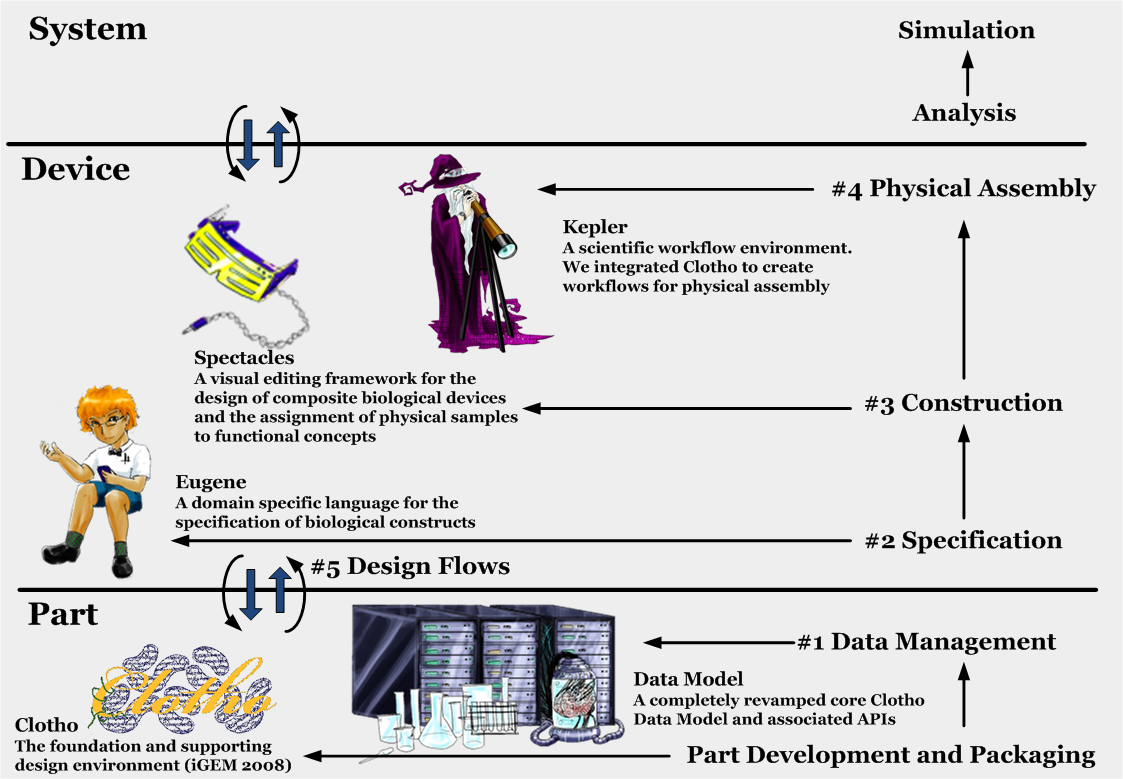Team:Berkeley Software/Project
From 2009.igem.org
| Line 17: | Line 17: | ||
|intro= | |intro= | ||
| - | <font size="4">I</font>n any design process there exists a hierarchy of design activities. Higher level activities build upon lower level activities leading to two design approaches: bottom up design and top down design. | + | <font size="4">I</font>n any design process there exists a hierarchy of design activities. Higher level activities build upon lower level activities leading to two design approaches: bottom up design and top down design. Bottom up design begins with primitive elements. These elements are combined to form more complex designs. This process is driven by a number of local objective functions. These objectives are abstracted at each level until at the end of the process, a large global objective is met. Top down design, starts with a specification and global objectives and decomposes this problem into smaller sub-problems each with their own objectives. This continues until all the primitive elements are specified. A synthetic biology moves into a more engineering oriented discipline we see a hierarchy appearing as well. This consists of: |
| + | |||
| + | * System | ||
| + | * Device | ||
| + | * Part | ||
| + | |||
| + | Each level has a number of design activities associated with it. A sample of these are shown on the right hand side in the figure below. With this hierarchy in place it now becomes a task of creating software tools which span this hierarchy. It is not enough to just put tools in place at each level however. They must be unified such that design flows are enabled which allow both top down and bottom up design activities. | ||
| + | |||
| + | Our project attempts to do just that. By beginning with the Clotho development as our foundation we focused on device level activities with Eugene, Spectacles and Kepler. In addition, we strengthened part level development by totally revamping Clotho's core data model and associated APIs. Clotho now is a much more developer and user friendly. | ||
|content= | |content= | ||
Revision as of 23:00, 11 October 2009
Our Project
Contents |
Introduction
In any design process there exists a hierarchy of design activities. Higher level activities build upon lower level activities leading to two design approaches: bottom up design and top down design. Bottom up design begins with primitive elements. These elements are combined to form more complex designs. This process is driven by a number of local objective functions. These objectives are abstracted at each level until at the end of the process, a large global objective is met. Top down design, starts with a specification and global objectives and decomposes this problem into smaller sub-problems each with their own objectives. This continues until all the primitive elements are specified. A synthetic biology moves into a more engineering oriented discipline we see a hierarchy appearing as well. This consists of:
- System
- Device
- Part
Each level has a number of design activities associated with it. A sample of these are shown on the right hand side in the figure below. With this hierarchy in place it now becomes a task of creating software tools which span this hierarchy. It is not enough to just put tools in place at each level however. They must be unified such that design flows are enabled which allow both top down and bottom up design activities.
Our project attempts to do just that. By beginning with the Clotho development as our foundation we focused on device level activities with Eugene, Spectacles and Kepler. In addition, we strengthened part level development by totally revamping Clotho's core data model and associated APIs. Clotho now is a much more developer and user friendly.
#1 Data Management
The key challenges in data management are: storing data, retrieving data, using data, and sharing data. These challenges in synthetic biology are made more difficult by the relative infancy of the field coupled with the vast number of differing interpretations regarding data organization and data relationships.
#2 Specification
#3 Construction
#4 Physical Assembly
#5 Design Flows
 "
"
